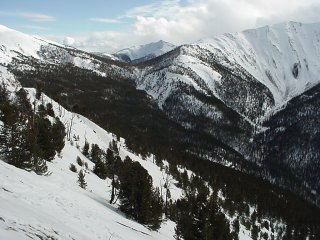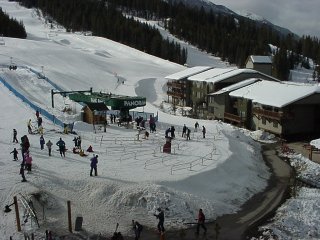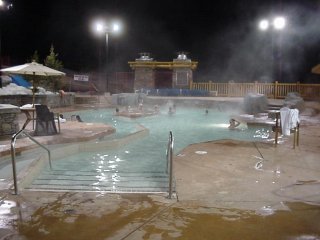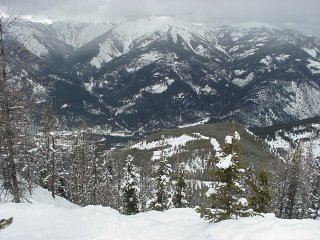Panorama (BC), Canada – There might be prettier vistas than
the ones we had of Invermere, the 20+mile-long valley lake, nestled between
the Rockies and the Purcells, the one Panorama’s literature calls “charming.”
Perhaps lakeside splendor was just down the road, around a bend; or perhaps
we were jaded. Several hours before, we’d been clamboring up on the car top
in the Chateau Lake Louise parking lot, where non-paying guests like us weren’t
supposed to be, trying in vain to see over the 15-foot snow banks and snap the
quintessential photograph, the one that had eluded the likes of Ansell Adams
when he put the surreally beautiful Mirror Lake to film. After a day of skiing
at Lake Louise, we’d driven across the stunning Vermilion and Sinclair Passes
through the Kootenay National Park’s Canadian Rockies, awed at the mountain’s,
umm, rocky, for want of a better word, grandeur. Perhaps we were beauty-numb.
n
We’d driven through a 50 foot chasm, vertical walls no more than 25 feet apart
as we left the Rockies proper in the hot springs town of Radium. Then, at about
the 100 mile mark, things began to change. We pushed on down long, flattened
miles, down into long, flat and wide Columbia Valley, where the river meanders
North before turning to make its reluctant way into the state of Washington.
There, a broad sea of flatness, so distressful to the skiing spirit, lay like
a desert between two awesome ranges. And there, at the base of that desert,
was Invermere, a dusty town that distinguished itself to us by its collision
shops, its industrial parks and its run-down fuel depots. Trust me, we were
not in a hurry to bury our toes in the lakeside sand (ok, so it was March, and
long past sundown; I’m trying to make a point here). No, we were on our way
to Panorama, confident, so we told ourselves, but in truth just a sketch uncertain,
that certainly the newly developed Intrawest resort would be nothing like this
chunk of darkest New Jersey transported to the eastern reaches of British Columbia.
|
Near Panorama’s summit
At Panorama’s base
Panorama Springs |
Certainly not. The road began its climb West into the Purcells and for sure
we weren’t in Jersey anymore. No, now we were on a deserted two-lane, winding
along the side of a mountain, past endless miles (18 km.) of barbed wire and
cattle range. Not a store, barely a house along the way. One roadside billboard
(in fact, the only roadside billboard, if memory serves) confirmed that we were
indeed on route to the resort–without it, we might have turned around, so unrelievedly
glitz-less was this corner of the world.
But maybe it was all a dramatic setup, crafted to inspire the shock one couldn’t
help but feel when after this drive, one emerged, blinking, from the back seat,
stretched ski-weary, stiffened legs and stumbled into the cool, computerized,
rustic-modern elegance of the Panorama Welcome Center. Fresh coats of paint,
new enough to smell, rich amber-colored wood paneling, efficient, friendly staff
and photographs on the wall, both luscious new sharp color scenes and pleasingly
retro, but oh-so-elegantly framed, sepia scenes of yesteryear, all told us that
without a doubt, we had crossed a frontier into the land of luxe. And, we were
to find out in the morning, the land of luxe skiing.
But first, a dip in the Panorama Springs outdoor heated pools. Yes, plural.
And sauna. All quickly reached from the warm and comfortable and clean-smelling
changing rooms. We soaked our bones in preparation for tomorrow’s 4000 feet
of vertical. Ah yes, watching the frost condense in air as one exhaled (in truth,
it wasn’t that cold, barely below freezing) as one’s innards are warmed by hot
aqua. Several skiers enjoyed extending their day on nearby slopes illuminated
by sodium vapor lamps for night skiing. This is my idea of après-ski
perfection. My friends preferred theirs a bit rowdier, and they were not disappointed,
but that would be tomorrow night. For the moment, our late night intro to Panorama’s
wood-paneled elegance bespoke creature comfort. And visions inspired by those
magical—at least to this Easterner—words: 4000 feet of vertical. I was looking
forward to this.
By breakfast I was chomping at the bit, hardly able to take in the words our
diligent host was pouring in our ears. The future of Panorama, he told us, is
dependent on golf and year-round tourism (and, yes, as a matter of fact, I had
seen some greens photos on the wall that had given the golfophobe in me amoment’s
pause). The development of Panorama is proceding very carefully (good, good,
I’m very glad). They hope to draw day-trippers from Calgary (seems a long ways
to me, but not my problem). They had a unique little continuous Cabriolet lift
to carry day-folk up from parking to the lodge (yes, truly cute; I never had
need or urge to try it). Birds are available for hire at the adjacent R.K. Heli-Ski
operation.
And for the 2000-2001 season, they were developing a whole new side of the
mountain for skiing. The Taynton Bowl expansion project was completed on schedule
in time for this winter. Featuring over 700 acres of backcountry-tyle naturally
gladed skiing, it brings Panorama Mountain Village’s total terrain to over 2,700
acres. Recently acquired from R.K. Heli-Ski, the area was brought into the recreational
boundary with access off the Summit lift and skiing out over 5km to the village.
The main chutes in Taynton Bowl provide over 1,700 vertical feet of descent.
I’d been drifting off from the conversation. My single-minded interest was
in what was open now to ski, but this new topic was at least a bit closer to
my thoughts. To be polite, I asked about new lifts, figuring our host could
boast about the the new Doppelganger or something. No, our host explained, everything
was easily accessible off the current inverted Y lift system. Huh?
I freaked. Suddenly it occurred to me to pay attention to the lift maps people
had been putting in front of my face. It dawned on me that this whole giant
mountain had, in effect, only one way up. The 4000 feet of vertical I was itching
to ski, I began to suspect, would be all eaten up in useless, frustrating, and
endless traverses. I knew there was a catch… My skin went white. I began to
hyperventilate. Our host begged me not to worry, that Panorama “skis big.” I
was unconvinced.
|
(click on image to |
Stop. Whoa. Reality break. My fears were groundless. But first a note of explanation.
Panorama’s 5 main lifts form an inverted Y. The bottom two feed from opposite
sides of the base area up into the upper three, which are arranged in a chain
(the last two of those being surface T- and J-Bars). Indeed, there is no taking
some “other” lift to some “other” part of the mountain. You visit other slopes
by angling down.
Whether it was the absolute quantity of the vertical or just a particularly
fortuitous trail map I cannot say, but I never felt like I was squandering precious
North-South vertical by travelling East and West. Be assured: Panorama’s got
plenty to ski. And those 4000 feet are all truly skiable, non-stop. But I’m
ahead of myself. First comes that curious/nervous/excited rite of the first
visit to a new ski mountain: the first ride up. Or, in Panorama’s case, the
first four rides up.
I think it was somewhere on the second lift that I turned to my buddy and offered
what, in retrospect, turned out to be for us the definition of Panorama: “Yaknow?
This place feels like an East Coast mountain on steroids.”
I say that as one who loves Eastern skiing. I say that as one who has visited
less Western resorts than can be counted on ten fingers. I say that as one who
is aware that the West has the reputation and that some might consider a comparison
to the Appalachians a major put-down. I say that meaning it as a compliment.
On the March days we skied Panorama, deep fluffy Rocky Mountain powder was
nowhere to be seen. In fact, low natural snowfall (an annual average of 145
inches) is Panorama’s principal drawback, along with a significantly lower base
elevation than its Alberta neighbors. The well-settled snow, both groomed and
un-, felt solidly familiar under my Eastern skis. But mostly, I felt at home
among the trees. Panorama is entirely below treeline. You ski trails, not faces
or bowls. I know to many—even to my friends—this is heresy, but… I love that.
Wide open spaces are for mindless cattle. Give me a forest of green and white.
Give me twisty trails (or better yet, glades) to wind my way through and down.
That is what I ski for.
What Panorama’s got that the East ain’t got, though, is more. Folks, 4000 feet
is a long way down, and my first get-acqainted run was a series of groomers.
And what Panorama ain’t got that the East’s got too much of is people. Those
groomers were done at a blissful, blistering pace. A pace that, at most of the
places I ski, would, or should, get you thrown off the mountain, hopefully before
you break somebody else’s neck. My first run, down blues and even greens that
would be blues and blacks back home, was a giant telemark yeeha, stopping long
enough to catch my breath and site far down the mountain at where I’d head to
next, then take off like a bat outta hell. My first run had been geographically
unadventurous, keeping pretty much near the lift line, and—not my usual preference—all
on groomers. I ended it with an ear-to-ear grin that pretty much stayed in place
for the next two days.
Now it was time to start exploring.
|
|
Back up the Y-chain, at the peak, was the little section of trail map my friends
had come here for, the Extreme Dream Zone, all marked double-black. As the timid
sort of push-myself skier, I decided to wait a bit for that section and stop
3/4 of the way up, top of the first surface lift, where you can enter just below
the EDZ, in an area known as Champagne. Here was a concave maze of twisty trails,
weaving across a foresty bowl. And with views to die for, as at every here and
there you’d round a corner and the distant mountains would open up.
The trails are steep, just deserving of their double blacks, but not overpowering,
and not spiced with treacherous turn-or-die corners. My downhill buddies wished
the snow were a bit lighter, but on teles, the snow felt thick and turnable.
I found the section challenging but manageable, and soul-satisfyingly wild.
We saw no other skiers in the area, the trails were cut to conform with the
terrain, and the overall sensation was more like travelling through a mountainside
nature preserve than skiing at a resort. I like that. Too soon the final traverse
popped us out near the top of the second lift. Ah well, just have to zip screaming
down those endless groomers again, feel the wind behind my ears. Not a bad way
to shake out the legs. (Later I found Black Bear, parallel to the groomers,
which became a preferred alternative, a mogulled and more woody trail.)
A note about the mountain’s shape. I’m no topo-reader/decipherer so I can’t
say for sure, but the whole hill must be slightly concave. That is, steeper
on the top half than the bottom. The distribution of greens, blues and blacks
seems to bear this out. The most striking evidence, though, is the view from
the base area. A quick glance upwards and you’re looking at the moutain peak,
4000 hard-to-believe verts above, plain as day. The hard-to-believe part sets
in as you ride those four lifts to get back up there.
To skier’s left from the peak is another alternative to the EDZ, an area of
mixed blacks and double blacks, plus the aptly-named Getmedown blue. The defining
trail there for me was Treetime or Tight Spots—I never was sure which—but the
effect was something like a romp through a Christmas tree farm. The pines were
mostly single trees, never impenetrably dense but all close enough together
so you could not plan more than two turns ahead. I like that too. It was a bit
disorienting, never knowing too well if you were halfway down or three quarters,
of way left or right in the middle, but in fact, you couldn’t help but come
out on the clear traverse from top of 3rd lift to bottom of 4th.
The snow was lightly mogulled as it wrapped its way around the trees and each
little 15 yard section was a distinct little ski problem to solve, and quickly,
if you please—all the exact opposite of the go-for-broke boulevards further
down on the moutain. Uhh, I like that, too.
Continue down from the base of the top J-bar and you reach Sun Bowl, a happy,
pleasant area. It is indeed sunny and treeless, but feels less like a bowl than
a big open field. On my days there the ungroomed was thin and hard and, contrary
to my normal inclination, uninviting. But the groomed pathways made fast, wide
and easy esses across and down the face. Great cruising terrain. Towards the
bottom was a section of well-spaced moguls, perfectly designed, so it seemed,
to make me a bump hero—in my eyes, at least, if in no one else’s. A shoulder-wide
traverse, mostly flat but with a few short, dippy thrills, led back to the bases.
|
Within the Extreme Dream Zone |
Fully primed, it was time now for the Extreme Dream Zone. Three entrances at
the top, skier’s right from the peak, seemed little different one from the other.
All could be simply summed up in a single word: steep, with the main one, Gunbarrel,
just slightly less treed than its alternates. It’s terrain I both love and fear,
familiar to me from the mountain forests of my favorite Vermont slopes. At the
top, my mind cycles endlessly, “can I handle it? I gotta try.” Often enough
at Stowe or Mad River, a small patch of ice will quickly supply a most awkward
and humbling answer. I stared down at Gunbarrel, then dropped in with trepidation.
Then a gleeful surprise. The same snow conditions as in the Champagne area below
were in effect here. The surface was absolutely manageable. Panorama is
like an East Coast resort, on steroids, and with easier snow. I turned my way
down, not fast, not carefree, but with the unshakeable knowledge that yes, I
could keep my head above water.
That is, until I reached Orca. At the bottom of the EDZ lies what struck me
as Panaorama’s only true bowl, a treeless half-cup of, for me, terror. My friends
like bowls. I do not. I made it down. I was glad when I did. That’s all I’ll
say. (On subsequent EDZ runs, the killer whale at the bottom seemed slightly
less monstrous. I never stopped wishing it weren’t there.)
Also on skier’s right was my other brush with fear. Our group decided to test
out the OB way off to the right and above the View of 1000 Peaks area (which,
by the way, well deserves its name; you look across the valley to, oh, I’d say
about a thousand sharp and craggy peaks streched from near to horizon). On our
exploration we cruised down sweet-looking untracked above the cut trails. Or
thought we’d cruise. The tempting snow was heavy as molasses and thick as cement
and, where we finally got enough pitch to keep moving, it was ready, so my friends
said, to slide. We were glad to bushwhack back onto groomed McIntosh Way.
Incidentally, below McIntosh, still far to skier’s right was the only area
of Panorama I found disappointing: The "View of 1000 Peaks" area proper.
On the map it looks woody, and the trails are named called Duthie’s Forest,
Moore Glade, Joe C’s Forest Gunner’s Glade, but the reality is a scrubbly little
area of dead tree stumps and bad snow. Maybe in February it’s delightful. Not
on March 10.
|
Elkhorn Cabin, operated |
But back to the plus side. Two other little surprises lay for me near the mountain’s
bottom. One was the Sunbird area, under the “other” fork of the lift system’s
inverted Y. The snow beneath the chair was ungroomed but well travelled and
formed into delicious rounded bumps. Runs were tiring—it seemed to go on forever—but
deeply satisfying (and when we wound up there a good ten fifteen minutes past
last chair at 4, the lifties waved us hassle-free back on, to save us the long
flat slog back to base).
And last happy shock was the out-of-nowhere Cliff Glade. Way near the bottom
of the mountain, surrounded by blues, is this unlikely, double fall line, double
black. There was an orange rope across the entrance to keep out the mountain
lions, or at least all the mountain lions that pay attention to such things,
but for a couple humans on the last hours of their ski pass, the trail was irresistable.
A short little uphill accounted for the steepness to follow, and what lovely
steepness it was. Snow cover was light, but to this Easterner’s eyes, plenty
adequate, as the trail led down an open, left-slanting, big hill/small cliff
side. Due to the moutain lion warnings, we only tried it once, but I’d gladly
come back to try all the other possible lines down this one little trail.
What about night life? I have no idea. My friends came back happy and beer-sodden
from their night on the, uh, lodge area (the place does seem a bit hermetic)
so I guess it’s fine. My idea of après-ski is sleep. What about sleep?
The lodge rooms were modern and well appointed but, what is the word for the
opposite of spacious? Claustrophobic? Suffice it to say that due to the unwieldly
presence of a bed, the bedroom door could not be opened more than a crack. Still,
once asleep, such considerations are of little import. By morning I was itching
once again to get back on the slopes and by second night I was sorry to say
goodbye.







